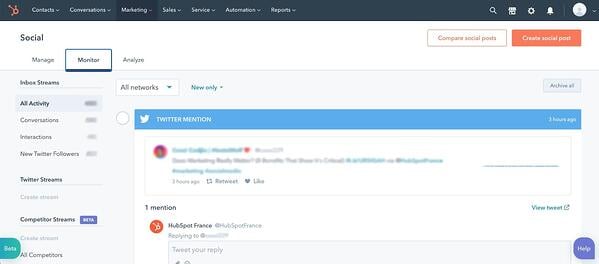Whether you’re a new or seasoned social media manager, managing a brand’s social presence can be overwhelming. After all, you’re behind every post and every interaction with potential customers so the pressure is on.
One way to ease that and make sure you’re at the top of your game is with a social media checklist. In this article, we’ll cover the daily and monthly tasks every social media manager needs to succeed.
Social Media Tasks
Before we get into the checklist, we’re going to break down the work of a social media manager into four pillars.
- Sharing – You must post on social media regularly to grow and maintain an audience.
- Engaging – Connecting with your audience, via polls, responding to comments and DMs, and reposting user-generated content, is key to building that brand loyalty.
- Monitoring – It’s important to know how your brand is perceived online, so you’ll need to monitor mentions of your brand as well as topics within your industry.
- Reviewing and Optimizing – If you’re not reviewing your performance, how can you improve? This is a necessary part of every social media strategy.
If you don’t share often, you’ll struggle to build an audience. Without an audience, you won’t have much to engage with. This also means that you’ll have little to no data about what works well and nothing to optimize or review.
This is all to say that to have a robust social media presence, you must be strong in all four areas. Now, let’s dive into the daily tasks you’ll need to complete in this role.
Social Media Daily Checklist
On a daily basis, you will be focused on the first three pillars: sharing, engaging, and monitoring.
While there is some reviewing and optimizing that can happen daily, you can better identify patterns when you do so on a monthly basis once you have compiled a good data set.
1. Sharing content.
Your number one priority on social media should be sharing content.
That’s what will allow you to reach your target audience, attract them to your brand, and keep them engaged.
When we surveyed 310 U.S.-based marketers in 2022, we found that most social media marketers post between four to six times a week on social media platforms.
While that is the average, some marketers post more or less depending on the platform. For instance, 29% of marketers surveyed said they post on Facebook every day while 35% said they do the same on Twitter.
However, when asked about Pinterest, most marketers surveyed only post two to three times a week.
Of course, how often you post will depend on a variety of factors including the return on investment.
Something else to consider is that sharing content doesn’t only mean from your brand. It can include user-generated content or content from another non-competitor that would add value to your audience.
2. Responding to comments and DMs.
One of the easiest ways to engage your audience is by responding to their comments.
If you’re struggling to generate comments in the first place, try starting a conversation and asking your audience to join it.
In this post, sunscreen brand KINLÒ asks its audience to share ways they protect their skin.
In that same vein, you can ask your audience to tag a friend that would enjoy your post.
Another way to engage your audience is by responding to direct messages. Often, consumers will reach out to brands on social media to learn more about the brand, ask specific questions related to shared content, or get help.
It’s important that you review these questions every day to leave a positive impression on your audience. If you take too long to answer, they may lose interest or escalate the issue by complaining to the public.
You can take it one step further by working internally with your customer support team to develop an escalation process once a customer reaches out via social media.
3. Monitor brand mentions and industry-related content.
When you’re growing your business, it’s vital that you know how your brand is being perceived online and what is being said about it.
According to our 2022 social media marketing report, 35% of marketers surveyed track brand mentions and hashtags on social media.
Thankfully with social media, that information is within reach. You can easily set up alerts to be noticed whenever your brand is tagged or mentioned on social media.
You can also routinely do searches on platforms like TikTok where alerts aren’t readily available.
This will allow you to gauge brand sentiment and quickly address concerns from your target audience.

Pro-tip: HubSpot’s social media management software includes a brand monitoring tool that will help you stay on top of all mentions and even track your competitors.
4. Identify trends and buzzy content.
Trends come and go just about every week on social media.
The trick is jumping in as they’re growing in popularity and knowing when they’ve died out.
The best way to find trends is by simply being on social media – social listening. You may start to notice a particular sound being used often or a song being added to every Reel you come across.
Some social platforms will tell you exactly what’s trending, like on TikTok’s “Discover” tab and Twitter’s “Trending” tab.

There are also accounts that are dedicated to finding trends as they happen and explaining their origin. This will help you determine which ones are worth joining and which ones you should stay out of.
As a brand, everything you put out there is a representation of your values. That’s why it’s important that you be extra careful when assessing trends.
See what videos other brands and users are creating with that trend. Are they funny and creative? Are they offensive? Do they align with your brand?
If not, it’s always OK to skip because there’ll be another one coming around the corner.
5. Answer queries on forums.
When we think of social media, we often think of content-sharing apps like TikTok, Twitter, and Twitch.
However, some social apps – think Reddit and Quora – focus instead on conversations and community.
You may be surprised to find how many conversations people may be having about your brand on these websites. In addition to being a great source of information surrounding brand sentiment, you can also learn a lot about your audience’s challenges and pain points.
You can then leverage that information into value-packed posts to attract your audience.
6. Connect with brand evangelists.
Building brand loyalty is no easy feat. So once you’ve accomplished it, you have to invest time to maintain it.
This means connecting with your brand evangelists on a regular basis.
Yes! 😍
— Brandon Blackwood (@BBlackwoodNYC)
April 27, 2022
This can look like commenting on their content and/or sharing it on your platform, giving them access to exclusive content, shouting them out, and inviting them to participate during live streams.
While social media can be filled with parasocial relationships, don’t let that be the case for you and your audience.
Social Media Monthly Checklist
1. Check your analytics.
Data is every brand’s most sacred asset. It holds incredibly valuable insights about your target audience.
On social media, your data will tell you the type of content your audience enjoys, what grabs their attention, and what generates conversions.
It will also help you identify trends. In fact, when we asked social media marketers “How do you predict which social media trends are worth investing in?” The top answer was by analyzing their social media analytics.
So, which metrics are marketers reviewing? Here are the top five, according to our survey:
- Likes and comments (41%)
- Sales (41%)
- Traffic to their website (41%)
- Impressions and views (40%)
- Brand mentions and hashtags (35%)
If you have at least one month’s worth of data, you can start finding out which posts perform the best and dig into the why.
Through your analytics, you can also assess which social platforms are worth investing in. According to our survey, the top three metrics marketers look at to make this decision are:
- Impressions/views
- Sales
- Follower or subscriber count
Whether you’re already succeeding or struggling on social media, reviewing your data will always set you up for a better month ahead.
2. Set goals.
Once you’ve reviewed your analytics and know what went well and what can be improved, you can set your goals for next month.
For instance, say you notice that last month’s videos outperformed any other content type and generated 2,000 visits to your website. For next month, you can up the number of videos you post and set a visit goal of 3,000.
Whether it’s increasing your reach, generating more engagement, or driving more traffic to your website, setting goals will serve as your north star and allow you to schedule content that aligns with these goals.
3. Schedule next month’s content.
When you’re managing multiple social media accounts, you have to plan your content ahead of time. Otherwise, you risk under planning and not having enough content.
You’ve already set your goals for the month. So now, it’s just a matter of creating content that best aligns with them.
For instance, say you want to increase your reach and last month’s data shows that your most shared content relates to three main topics. You can then center next month’s content on these three topics.
When scheduling content, you should also consult other teams to determine if there are any events, announcements, or campaigns that you will need to share.
The earlier you have your creative assets – images, videos, copy – the easier it will be to create your content calendar.
Pro-tip: We created a social media content calendar template to make planning posts and coordinating campaigns easy.
There you have it – a detailed social media checklist that will have you on top of your game every day.
![]()

